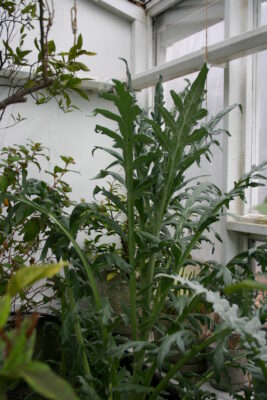
Here in coastal Rhode Island, I live in the US Department of Agriculture’s Plant Hardiness Zone 7a. This zone has a medium-length growing season and winter temperatures that, at their coldest, can drop to between 0° and 5°F. This makes growing artichokes outdoors difficult. These plants prefer a more temperate climate because most set buds (the edible part we eat) only in their second year after experiencing a moderate winter, so if winter is extremely cold, they will likely die before they produce. Artichokes can withstand light frost, but not the intense cold that New England winters can sometimes bring. This is why my greenhouse has become an essential part of my artichoke-growing strategy.
To begin growing artichokes either outdoors or in a greenhouse, there are several varieties to choose from, some of which can be grown successfully as annuals, although others are better grown as perennials. Green Globe is the most common artichoke and the one most often grown in California. Because it is adapted to more temperate climates, it is not ideally suited for growing here. A better variety for colder climates is Imperial Star, which, if cut back and well mulched, is said to be able to winterover outdoors in zone 8, which is more moderate than zone 7. For warmer areas, the Italian artichoke Purple of Romagna is a good choice, as is another Italian variety, Violetto. This year I started all four of these varieties to see which is best for our area.

Typically, I start artichoke seeds around the end of January in my basement germination chamber. That’s a fancy name for grow-lights positioned over plant trays. At about 70 degrees F, the seeds germinate in about a week. The plants are left to grow in the basement for about six weeks, at which point they have at least two true leaves and are transplanted into 4-inch pots. After they have settled in new pots, I put the plants in my heated greenhouse for a week to harden them off before planting them directly into the soil of my unheated greenhouse. By now it’s late March or early April when severe cold is usually over, although usually the temperature is still cool enough to encourage the plants to set buds. If the plant sets buds, they will increase in size over the next 100 days but must be harvested before becoming large, thistle-like flowers. When you snip off a bud, the plant will usually produce several smaller buds that can grow and be harvested later.

Artichokes are very hungry and thirsty plants, requiring a lot of nutrients and water. So before moving newly-started plants into my unheated greenhouse, I prepare the soil there by adding lots of well-rotted horse manure and compost. Then, after the artichokes are planted, I water them copiously, but not so much that the soil is persistently wet, a condition that the plants don’t like. With the right amounts of moisture and feeding, artichokes will thrive, growing to a height of five feet (1.6 m) or even taller, usually with one or two thick stalks.
Come fall, I give the artichoke plants in my unheated greenhouse the best shot I can at surviving the winter there. I cut the plants back to about 3 inches above the roots and cover them with a thick mulch of compost and leaves. In spring, I rake off the mulch and fertilize the plants. Hopefully, they’ll be ready for a new season of growth and bud production. What’s more, after growing for two or three years, artichokes will generally sprout side shoots that can be removed in early spring and cultivated to become separate plants. In this way, you can increase your artichoke harvest without always starting new plants from seed.


